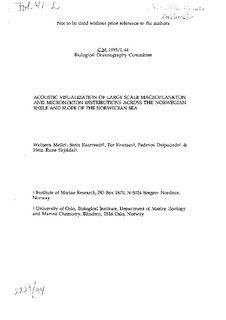Acoustic visualization of large scale macroplankton and micronekton distributions across the Norwegian shelf and slope of the Norwegian Sea.
Working paper
Permanent lenke
http://hdl.handle.net/11250/105194Utgivelsesdato
1993Metadata
Vis full innførselSamlinger
Originalversjon
This report is not to be cited without prior reference to the authorsSammendrag
We present results from acoustical (38 kHz split beam) surveys, biological
sampling (trawling, zooplankton nets), and measurements of physical
parameters (salinity, temperature, currents) across and along the shelf off
Norway (62-70°N). Major recurrent structures were apparent both
geographically and with time. Off the shelf, two deep scattering layers
prevailed; one of 50-100 m thickness where the upper border by day
fluctuated between 100 and 200 m depth, and one located deeper between
300-500 m. The upper layer was mainly composed of mesopelagic fish
(Maurolicus muelleri) and krill (Meganyctiphanes norvegica), while the
lower layer consisted of krill (Meganyctiphanes norvegica), mesopelagic
fish (Maurolicus muelleri, Benthosema glaciale), shrimps (Sergestes
arcticus, Pasiphaea multidenta), and jellyfish (Periphylla periphylla).
During winter, these two layers roughly comprise 95% of the
backscattering volume (biomass) in the upper 500 m. The shallow layer
partly intrudes onto the continental shelf, where the bottom topography
exerts strong impact on its distribution.
In June/July an additional scattering layer was apparent in the upper 20-30
m throughout most of the study area, though integrated backscattering
biomass varied by a factor of 50. In the south the layer was associated with
water masses of salinity <35 (i.e. with coastal characteristics). Further north
the layer was found off the shelf in water with stronger oceanic
characteristics as well. Hydrographic features indicated that coastal water
and biomass was transported off the shelf in connection with gyres over
the banks. Trawl catches showed that this structure was composed of 0-
group herring, fish (mainly seith), and krill. Backscattering volume was
positively correlated with abundance of 0-group herring caught in trawl,
but was not correlated with the meso-zooplankton biomass (mainly
Calanus finmarchicus), or other components of the trawl catches. The lack
of positive correlations between acoustic backscattering volume, and
biomass from net and trawl samples probably reflected differences in
selectivity of the sampling methods.
